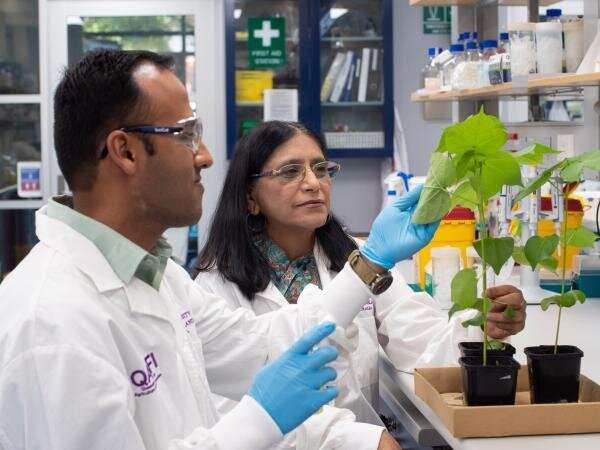Australian scientists Ritesh Jain (L) and Professor Neena Mitter say tests using BioClayTM on cotton plants are harmless to other insects including the stingless bee (Tetragonula hockingsi) and aphid (Myzus persicae). Credit: University of Queensland
An environmentally friendly spray that targets and kills one of cotton's (and the world's) most damaging agricultural pests—silverleaf whitefly—has been created by scientists at The University of Queensland.
The breakthrough is part of UQ's BioClay technology, a safe and sustainable alternative to chemical pesticides, which has been developed over the past decade by Queensland Alliance for Agriculture and Food Innovation (QAAFI) and the Australian Institute for Bioengineering and Nanotechnology (AIBN), with support from CRDC, Hort Innovation and Nufarm Ltd.
Research team leader Professor Neena Mitter said it was a game-changer for crop protection because it was effective against whitefly (Bemisia tabaci), a small insect responsible for the loss of billions of dollars in agricultural crops around the world.
"Silverleaf whitefly (SLW) is considered an invasive species in the United States, Australia, Africa and several European countries and attacks more than 500 plant species including cotton, pulses, chilli, capsicum, and many other vegetable crops," Professor Mitter said.
"The insect lays eggs on the underside of the leaves and the nymphs and adults suck the sap from the plant resulting in reduced yields."
In addition, whiteflies also transmit many viruses which pose a threat to healthy crops.
Control of the pest has been difficult due to its ability to quickly develop resistance to traditional chemical pesticides.
The BioClay spray uses degradable clay particles that carry double-stranded RNA which enters the plant and protects it without altering the plant's genome.
"It is the first time the BioClay platform has been used to target sap sucking insect pests," Professor Mitter said.
"When whiteflies try to feed on the sap, they also ingest the dsRNA, which kills the insect by targeting genes essential to its survival.
"The world of RNA is not just responsible for COVID-19 vaccines, it will also revolutionize the agricultural industry by protecting plants from viruses, fungi and insect pests," she said.
To identify suitable gene targets, Ph.D. candidate Ritesh Jain went through the global database of genome sequences.
"Initially, we had to screen hundreds of genes specific to SLW to see which ones would affect their growth," Mr. Jain said.
"Importantly, the dsRNA proved harmless when fed to other insects, such as stingless bees and aphids."
CRDC's Senior R&D Manager, Susan Maas says SLW is a major pest of cotton globally due to its ability to contaminate and downgrade lint quality.
"This innovation will support the industry to maintain Australia's reputation for producing uncontaminated, high-quality cotton in a safe and environmentally friendly way" Ms. Maas said.
Hort Innovation research and development manager, Dr. Vino Rajandran said the spray could give the industry another tool in its biosecurity armory. "It has the potential to save growers time and money and is a great example of industry levy investment in action," Dr. Rajandran said.
The researchers will now work with industry partner Nufarm Ltd to test the whitefly BioClay formulation in real-world production systems.
Nufarm's Global Lead for Transformational Projects, Mike Pointon said the company was "proud to be partnering with these world leading scientists to develop cutting-edge technologies that bring new, alternative control options to farmers."
The research is published in Nature Plants.
More information: Ritesh G. Jain et al, Foliar application of clay-delivered RNA interference for whitefly control, Nature Plants (2022). DOI: 10.1038/s41477-022-01152-8
Journal information: Nature Plants
Provided by University of Queensland
























